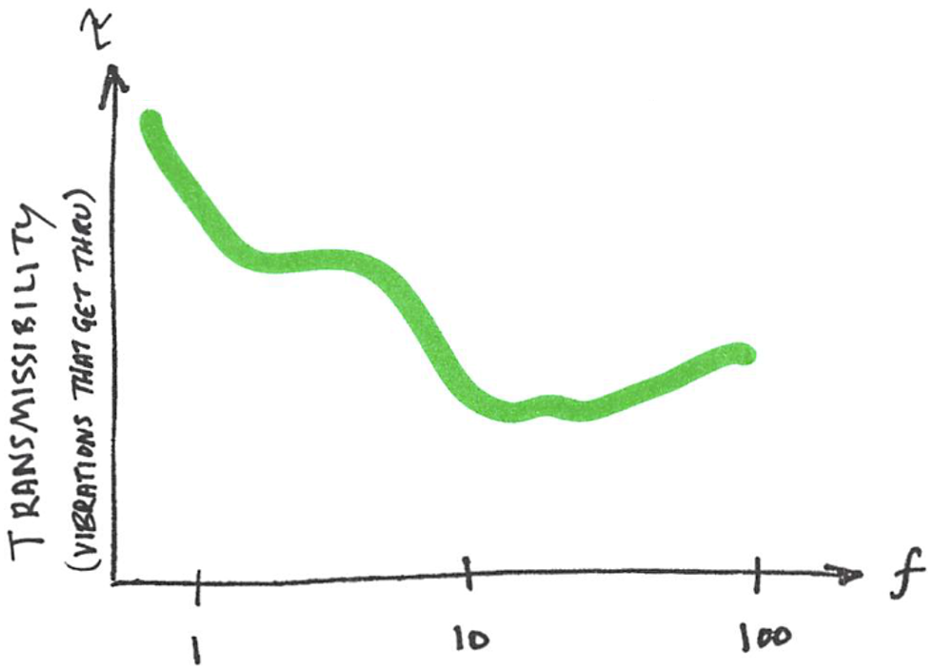Can we isolate this microscope from floor vibrations?
For projects that house sensitive instruments and activities – like nanotech labs or vivariums – vibration and noise impacts from the outside world can interfere with research productivity. When it comes to these environmental (rather than locally-generated) building vibrations, location is often the single most important variable. Usually, the farther you can get from external sources -- like major roadways or rail alignments -- the better.
Of course, most projects don't have the luxury of avoiding the sound and vibration sources that come with civilization: you have to put your building somewhere, and mostly due to cost and convenience, that somewhere is almost always going to be in a populated area.
Since there's only so much you can do about the environment, we are often asked about local vibration isolation systems that act right at the tools themselves. These are devices like active isolation pads that sit under electron microscopes as well as passive systems like pneumatically-floated-slabs (sometimes built into a pit in the foundation) or spring-based systems that cradle the tool in a height-saving outrigger. Conceptually, they are similar to air tables but are designed to sit below an otherwise floor-mounted tool. These systems are only getting better as technology improves, and you can't ignore the possibilities that they offer when it comes to micro-vibration problems in sensitive buildings.
An example transmissibility curve for a vibration isolation pad like those used to protect sensitive electron microscopes. Here, "transmissibility" can be thought of as the fraction of floor vibrations that get through the system and affect the microscope. Therefore, on this plot, lower is better: you would prefer that a lower fraction of building vibrations get through.
Of course, you'd probably prefer to avoid using these receiver-based vibration isolation systems in the first place: they are expensive; require at least a little maintenance; create elevation and/or footprint problems; and limit your flexibility when the system is “designed to the tool” or built into the foundation. What’s more, if you had to rely on an isolation system to meet a micro-vibration criterion for your nanotech lab, then what are you going to do when you buy or develop a new tool, with a more-demanding criterion? Anyway, quieter is almost always better, both for routine shared imaging suites as well as for lab groups who build or modify instruments.
From a technical perspective, though, the biggest thing to keep in mind is that these isolation schemes can only attenuate -- not eliminate -- floor vibrations. Furthermore, they aren’t equally effective at all frequencies: they universally work better at higher frequencies than at lower frequencies. Even the most-sophisticated receiver-based vibration isolation systems don't work very well below a few Hertz. This is important because many common imaging tools, like electron microscopes, are often more sensitive to micro-vibrations at lower frequencies than at higher frequencies.
As before, lower transmissibility means that less building vibration gets past the isolation system and into our microscope. Universally, isolation systems perform better at higher frequencies than at lower frequencies. This is important, because imaging tools are not equally sensitive to all frequencies, and also because lab environments do not exhibit uniform micro-vibration across the spectrum.
So, when you ask whether a marginal (but desirable) site could be made workable by putting an isolation pad under your SEM or TEM, you have to have some data describing the frequency content of that building vibration environment. If there’s a lot problematic floor vibration at very low frequencies, then your investment might not pay off the way you had hoped. On the other hand, if all the biggest problems are at middle and high frequencies, then an isolation system might be just the answer.
What this all means is that tool-based vibration isolation schemes aren't silver bullets. They can't remedy all building vibration deficiencies. Of course, they can be very useful in the right situations and can even rescue an otherwise impossible laboratory site. Just be aware of these limitations, and make sure you are working with good data as you proceed with design of your lab.


